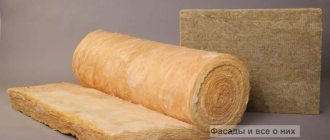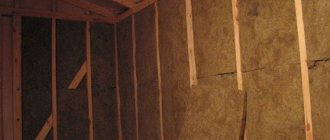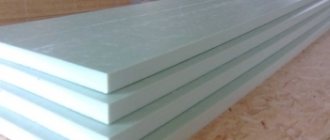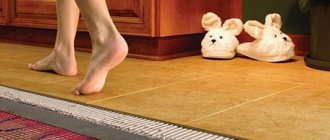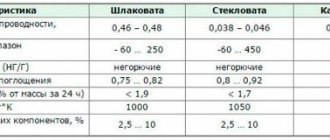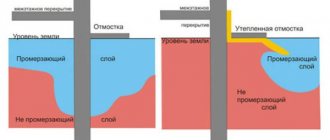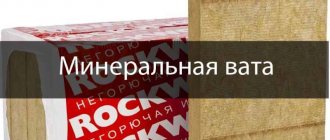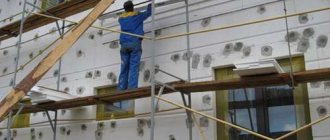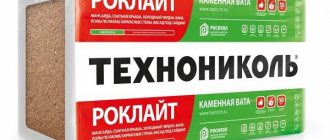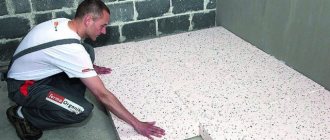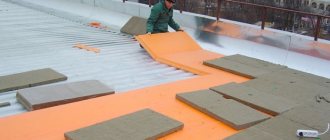If the facade insulation with expanded polystyrene is carried out taking into account technological standards, the result is a high level of thermal protection of the building. At the same time, the risk of heat loss is not only leveled, which contributes to a comfortable microclimate in the house and optimization of heating costs. Insulating the façade with expanded polystyrene improves the operational and decorative potential of the structure, since the technology involves the creation of a multi-layer composition with reinforcement, plaster and final finishing.
Material characteristics
Expanded polystyrene - porous insulation in the form of a rigid panel - has gas-filled microcells of a closed shape. The material is characterized by clear geometric dimensions and the presence of a joining edge, which facilitates convenient installation and provides the effect of a seamless surface.
The market offers several types of polystyrene foam boards. One of the popular solutions is considered to be an extruded analogue of products from the Penoplex brand, the name of which has become a household name and is used, among other things, in relation to products of this class from other manufacturers. The branded version of the insulation is orange in color. The brand’s line is varied, for example, “Penoplex-Comfort” and “Penoplex-Facade” are maximally adapted for thermal insulation of the external walls of a house.
Technical characteristics of extruded polystyrene foam:
- density – 25-35 kg/m³;
- fire resistance – G3-G4;
- bending strength – 0.25 MPa;
- compressive strength – 0.18-0.2 MPa;
- thermal conductivity coefficient – 0.030 W/(mx°C);
- water absorption – 0.4-0.5%;
- operating temperature range – from -100°C to +75°C.
What does expanded polystyrene look like?
The standard dimensions of the width and length of branded polystyrene foam are 60x120 cm, the thickness of the models varies between 2-15 cm.
Content:
- Insulation with polystyrene foam Insulation technology with polystyrene foam
- Surface preparation and sheet application technology
- Insulating the foundation of a house from the outside
- Floor insulation
Advantages and disadvantages
The key advantages of polystyrene foam insulation for facade work are considered to be an extremely low thermal conductivity coefficient; in this indicator, the material is second only to polyurethane foam.
The following advantages of Penoplex are also noted:
- high level of moisture resistance. The solution is able to maintain thermal insulation properties even in unfavorable conditions. For example, expanded polystyrene is in demand for underground insulation of foundations, as it is not afraid of contact with wet soil;
- excellent strength characteristics. Penoplex is resistant to mechanical stress, and is easy to cut using ordinary tools;
- expanded polystyrene as insulation for the facade of a house under plaster is inert to biohazards and unattractive to insect pests;
- has a wide operating temperature range, safety margin is designed for 50 freezing/thawing cycles;
- geometric features with clear shapes and the presence of an edge with a locking fastening system make installation easy.
Minuses:
- conditional “non-flammability” as a result of the use of fire retardants at the production stage only provides a reduction in flammability and determines the self-extinguishing properties. At the same time, when penoplex burns, highly toxic compounds are released, which poses a threat to human life and the environment;
- the material is exposed to chemically active substances, contact with which is fraught with destruction of the structure;
- polystyrene foam insulation is afraid of ultraviolet radiation and needs protection, which necessitates plastering work for high-quality thermal insulation of the facade of the house.
A big disadvantage is also the vapor-tightness properties of extruded polystyrene foam when used to insulate facades under plaster. Since there is no vapor permeability, the coating prevents the removal of moisture from the walls. The situation can be partially corrected with the help of internal vapor barrier of wall structures.
Why is thermal insulation needed?
Insulating facades with foam plastic is the right choice because it has many positive aspects:
- This is one of the most economical thermal insulation materials.
- expanded polystyrene has good thermal conductivity;
- operation does not require the use of additional methods of protection or vapor barrier;
- the material does not allow moisture to pass through, protects against the effects of microorganisms;
- the insulation is durable;
- polystyrene foam ensures easy installation.
However, this new insulation is highly flammable and produces acrid, toxic smoke when it burns. Also, small rodents can easily ruin it . But the good news is that there are many more advantages than negative aspects, so extruded is worthy of attention.
Types of expanded polystyrene
The following types of material are available on the market:
- pressed Produced under the brands PS-1 or PS-4, characterized by a high density in the range of 60-600 kg/m³, used in the radio engineering field;
- pressless. There are PSB and PSB-S brands; the material has high physical and chemical properties and is designed for thermal insulation of facades;
- extrusion It is characterized by high strength and durability, and is in demand as an effective facade insulation.
The disadvantage of pressed and unpressed samples is the risk of structural deformation when moisture gets between the granules at subzero temperatures. The service life of the extrusion analogue is designed for a period of 50-80 years, however, the composition contains residual styrene, which poses a threat to the environment.
What are the advantages of insulation?
Brick houses have a huge number of advantages compared to other materials. Such a building is reliable, stable and moisture resistant. A brick house will last for many years, and you will be confident in its integrity. But, like any stone, a brick building needs insulation, as heat consumption increases.
Insulating a brick house from the outside with polystyrene foam has the most positive effect on the thermal insulation characteristics of the building.
This is especially true during the cold season, when the masonry cools down under the influence of low temperatures, and it is more difficult to heat the room.
Therefore, it is necessary to use foam insulation on the outside of a brick house in order to:
- Save heat from heating the building. You can save quite a lot on electricity, which consequently leads to financial savings.
- Accumulate heat until the outside temperature reaches zero. So that when the cold weather begins, the heat in the rooms is not spent on warming the entire stone building.
- Internal insulation is done during the period when the walls are just being built. However, you should take care of your comfort by insulating the building from the outside as well.
- By insulating a brick house externally with polystyrene foam, rather than from the inside, you can avoid moisture condensation, and your room will not be filled with droplets of condensed air.
Material selection criteria
To insulate the facade of a house with your own hands, extruded polystyrene foam under plaster is most often used, and the following points are noted as the key selection criteria:
- strength and durability of insulation;
- ease of self-installation;
- flawless coating with the effect of seamless technology;
- relative availability of products.
Extruded polystyrene foam has durability and strength.
Experts recommend giving preference to branded products, not skimping on the quality of thermal insulation of the house facade, and adhering to the technology of installing polystyrene foam boards under plaster.
Installation of reinforcing mesh and finishing with plaster
- Reinforcing mesh is used to ensure greater rigidity of the plaster and prevent it from falling off the polystyrene foam. For this, a metal or plastic mesh with a small mesh size is used.
- First of all, you need to cover the window or door slopes and corners of the house . This is done with strips of mesh, cut about 30 cm wide and bent in half lengthwise to form a stable rib. All corner areas of the house are decorated with such “corners”.
- For plastering PPS, a special composition is used - a universal mass.
- The plaster is applied with a spatula to the corners and slopes formed with a mesh. In places where there will be joints with the main mesh, free areas are left for connecting the mesh panels.
- For laying on a plane, the mesh roll is cut into pieces of 1 m.
- A layer of plaster is applied, a piece of mesh is placed on it and pressed onto the plaster with a spatula. Using ironing movements, the mesh is pressed into the layer of universal mass, so that it is completely inside.
- The next piece is laid side by side with an overlap and the procedure is repeated.
- After the mesh is completely installed, the mixture is dried for several hours (up to a day), after which the composition must be grouted.
- Then a second leveling layer is laid, which is also rubbed down after drying . Grouting is done until the surface is completely smooth.
- After this, the surface is primed for greater reliability and durability of the coating.
- Finishing is carried out - painting, applying relief or decorative plaster, etc.
Installation sequence
Installation of reinforcing mesh
Insulating the facade with extruded polystyrene foam is a completely possible procedure, but it requires ensuring that steam is removed from the room using high-quality ventilation .
Failure to comply with this condition threatens the gradual accumulation of moisture inside the wall or in the gap between the wall and the PPS, which sooner or later will cause destruction or rotting of the walls. Otherwise, polystyrene is a completely reliable and inexpensive insulation material.
Do-it-yourself algorithm for insulating a façade with polystyrene foam
An important component of the external thermal insulation of the walls of a house with foam plastic is the preparatory stage, which consists of pre-treatment of the insulated surface.
Materials and tools
To thermally insulate the outside walls of a house with polystyrene foam slabs for do-it-yourself plaster, you will need the following set of materials, devices and tools:
- repair composition, primer, tools for preparatory work;
- level, plumb line, tape measure;
- electric drill, knife, hammer, spatulas, needle roller;
- umbrella dowels for fastening slabs;
- base profile and set of hardware;
- reinforcing mesh and corner profiles;
- plaster-adhesive mixture.
It is also necessary to have a container on hand for preparing the solution.
Material calculation
At the starting stage, it is necessary to calculate the optimal thickness of polystyrene foam slabs for insulating the facade of a house, their quantity, the required volumes of plaster-adhesive mixture and other materials.
The required thickness of external wall insulation should be determined taking into account the normalized value of the thermal resistance of building structures for a specific region. Next, the facade parameters (material, thickness dimensions) and thermal resistance data according to SNiP are entered into the online calculation calculator. The result in millimeters - the minimum value - is rounded up to the standard thickness of the slabs of the insulation in question.
The amount of thermal insulation using the “wet facade” technology is calculated based on the planned insulation area with a margin of 10%. To determine the consumption of the base profile, reinforcing mesh and corners, they are based on the configuration of the wall structure.
Preparatory stage
Preliminary preparation of the base is designed to ensure maximum density of fixation of the insulating board to the wall:
- protrusions should be eliminated, cracks should be sealed, and the surface should be leveled;
- Old paint and dirt are removed, the surface is treated with a deep penetration primer.
If there are metal elements on the wall in the form of brackets for satellite dishes or external units of air conditioning systems, anti-corrosion treatment is performed.
Nuances of the stages of installation work
After the primer coating has dried, the base profile is installed. To do this, a perfectly straight line is struck, encircling the facade with the exception of the doorways. The parts of the base profile are fixed to the wall using dowel fastenings. This starting structural element serves as a support for the lower row of slabs, is designed to regulate the evenness of the masonry, and helps protect the penoplex from below from rodents and atmospheric influences.
Before installation work, it is recommended to treat the insulation boards with a special needle roller or a coarse grater. This improves the adhesion properties of polystyrene foam to the solution. For the same purposes, the insulation is treated with the Betonokontakt primer.
The nuances of working with glue:
- the solution is prepared in batches. It is worth mixing as much as the glue consumption is planned for about an hour;
- when mixing the adhesive mixture, it is important to maintain the proportions according to the manufacturer’s instructions;
- add the dry mixture to a container with a measured amount of water and mix it with a construction mixer until it has a homogeneous consistency;
- the glue is applied along the perimeter of the slab in a continuous strip about 10 cm wide, in the center it is laid out in slides d20 cm high within 2 cm;
- if the wall is perfectly flat, spread the glue over the entire surface of the slab using a notched trowel.
Next, the insulation is applied to the attachment point and pressed tightly against the wall surface.
The nuances of installing penoplex:
- expanded polystyrene slabs are joined as tightly as possible using locking joints;
- the rows are laid out with offset vertical seams, in the corners the principle of dressing according to the “tooth lock” method is observed;
- The main means of fastening when installing insulation boards is glue. After the composition has set, penoplex is additionally fixed with dowels;
- dowel-umbrellas are installed in the center of the panel and in the corners, while the samples at the intersection of the seams support several adjacent slabs at once.
Installation of a façade with polystyrene foam.
Afterwards, you can seal the gaps between the fragments of insulation using polystyrene foam to eliminate cold bridges.
We apply plaster reinforcement
A plaster-adhesive solution is prepared, usually using the same composition that was used to glue the insulation. Reinforcing plaster is carried out starting from the corners of the walls; plaster profiles are used for this. On the rest of the surface, use pieces of mesh, rolling the strip from top to bottom.
Sequence of work:
- A layer of solution about 2-3 mm thick is applied on top of the penoplex; a notched trowel is used to distribute the composition.
- A strip of fiberglass mesh is applied to the mass, which is rolled vertically from the upper perimeter to the base profile. The reinforcing layer is completely embedded in the solution using a trowel. From below, the mesh is cut at the level of the base line.
- Adjacent strips of the mesh of plaster reinforcement are made with an overlap of within 10 cm, horizontal overlaps at the junction of two fragments are at least 15 cm.
It is important to exclude folds or wrinkles of the mesh; it is also necessary to forcefully embed it in the plaster, without leaving missing areas. The surface of the coating is simultaneously leveled with a trowel.
Finishing
After the reinforcing plaster has set, the duration of which varies depending on the composition and weather conditions, a covering-leveling layer of the same solution is applied. They start with the corners and slopes, then work on the remaining sections of the wall.
If the final finishing is planned in the form of facade paint, the thickness of the mixture is about 3 mm. It is important to give the surface a neat appearance, to grout and polish the coating as cleanly as possible. Under decorative plaster, a leveling layer with a thickness of 2 mm is applied.
Installation under siding
In order to perform insulation with polystyrene foam followed by finishing with siding, the installation of a sub-cladding system is required. It is constructed from a metal profile or wooden beam located vertically, with a pitch of no more than 40-60 cm. To fix the galvanized guides, brackets (suspensions) are used, which are attached to the wall with anchor elements or self-tapping screws.
The entire sheathing is leveled using a level, level, plumb line and fishing line. The type of material is selected depending on the panels used. Steel sheathing is ideal for metal siding. Its service life will be longer than wood.
It is important to know
Wooden beams must be treated with an antiseptic, and the use of a metal profile is allowed only if it is coated with zinc. To increase the service life, the profile can be painted using powder coating.
After the installation of the sheathing on the outside of the building is completed, insulation is carried out with polystyrene foam. If your choice fell on a wooden sheathing, then the slabs are installed between the guides, then fixed with the help of umbrella mushrooms. When using metal sheathing, the slabs are strung on brackets. Having completed fixing the panels to the walls, you can begin cladding with siding.
Technological standards for working with expanded polystyrene
The effectiveness of facade insulation with polystyrene foam under plaster depends on compliance with technological standards:
- the slabs are installed at a temperature of no more than +25°C and a relative air humidity of up to 80%;
- It is important to protect polystyrene foam from direct sunlight; it is necessary to plaster the façade surface in a timely manner;
- For installation work, you should choose a period without precipitation.
Moisture getting into the cracks between the tiles can reduce the effectiveness of thermal insulation. Precipitation and high air humidity contribute to the deterioration of the adhesiveness of the solution. It is important to comply with the requirements of the technology for insulating facades with polystyrene foam in order to predict the reliability and durability of the coating.
Is waterproofing necessary?
This question is often asked by those who decide to insulate their home. Waterproofing is a special material used to prevent moisture from penetrating into the interior of a structure. Waterproofing is a special membrane film that is laid either on top of the structure, or under the screed, or in other places prone to moisture accumulation.
It is difficult to give a definite answer as to whether waterproofing is needed when insulating with polystyrene foam: it depends on the specific room, its functional characteristics and the climatic conditions of the area.
For example, when insulating loggias and balconies, where condensation and steam often form, it is worth using waterproofing, and some craftsmen strongly advise using foil polyethylene instead of membranes.
External insulation work should be carried out in dry weather and air temperature not lower than 5 degrees and not higher than 25-30 degrees Celsius. In this case, each subsequent layer should be applied only after the previous one has completely dried.
Conditions for insulating external walls with foam plastic
Like any other construction process, insulating a brick house from the outside with polystyrene foam requires a special approach, in particular, this concerns the preliminary preparation of the work front. So, in order for polystyrene foam to hold tightly and perform its functions, it is necessary that the weather for the last three days be dry and without rain.
You can measure the air humidity yourself, or refer to weather forecasters - it should not be higher than eighty percent. Therefore, it is better to start insulating a brick house with polystyrene foam in the summer, when hot, dry weather makes it convenient to apply the insulating material.
As for the temperature that will be outside during the period of insulation, it should be no lower than 0-3 degrees C. Otherwise, the foam will not be securely fastened, and the heat in the house will still be consumed. This is another point in favor of the fact that this method of insulation should be carried out in the spring and summer.
Make sure that the craftsmen take seriously the base on which the heat-insulating material will be applied. There should be nothing foreign there so as not to interfere with the easy, quick and high-quality laying of the material.
After all, if anything interferes with the normal adhesion of the polystyrene foam together with the binding substances, insulating a brick house with polystyrene foam will not give the necessary dividends. Therefore, it is necessary to carefully treat the wall, ridding it of everything that may be unnecessary.
Pay attention to cracks and surface irregularities. If this is necessary, you need to re-prime the wall. Only after this process should we begin to insulate the house.
